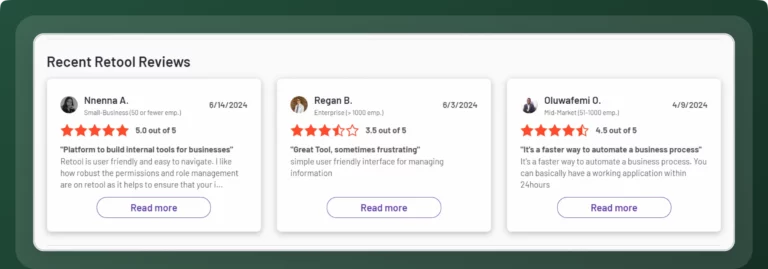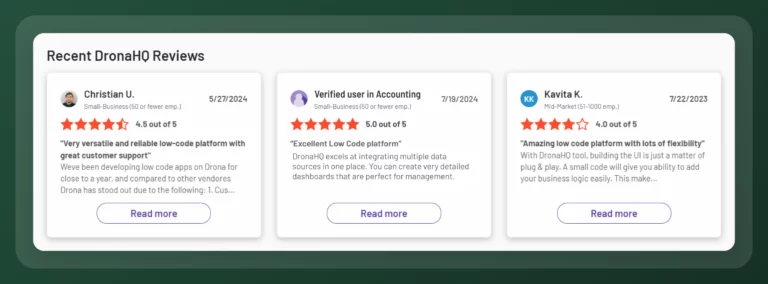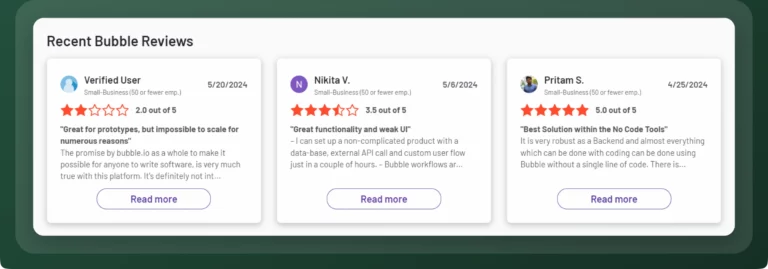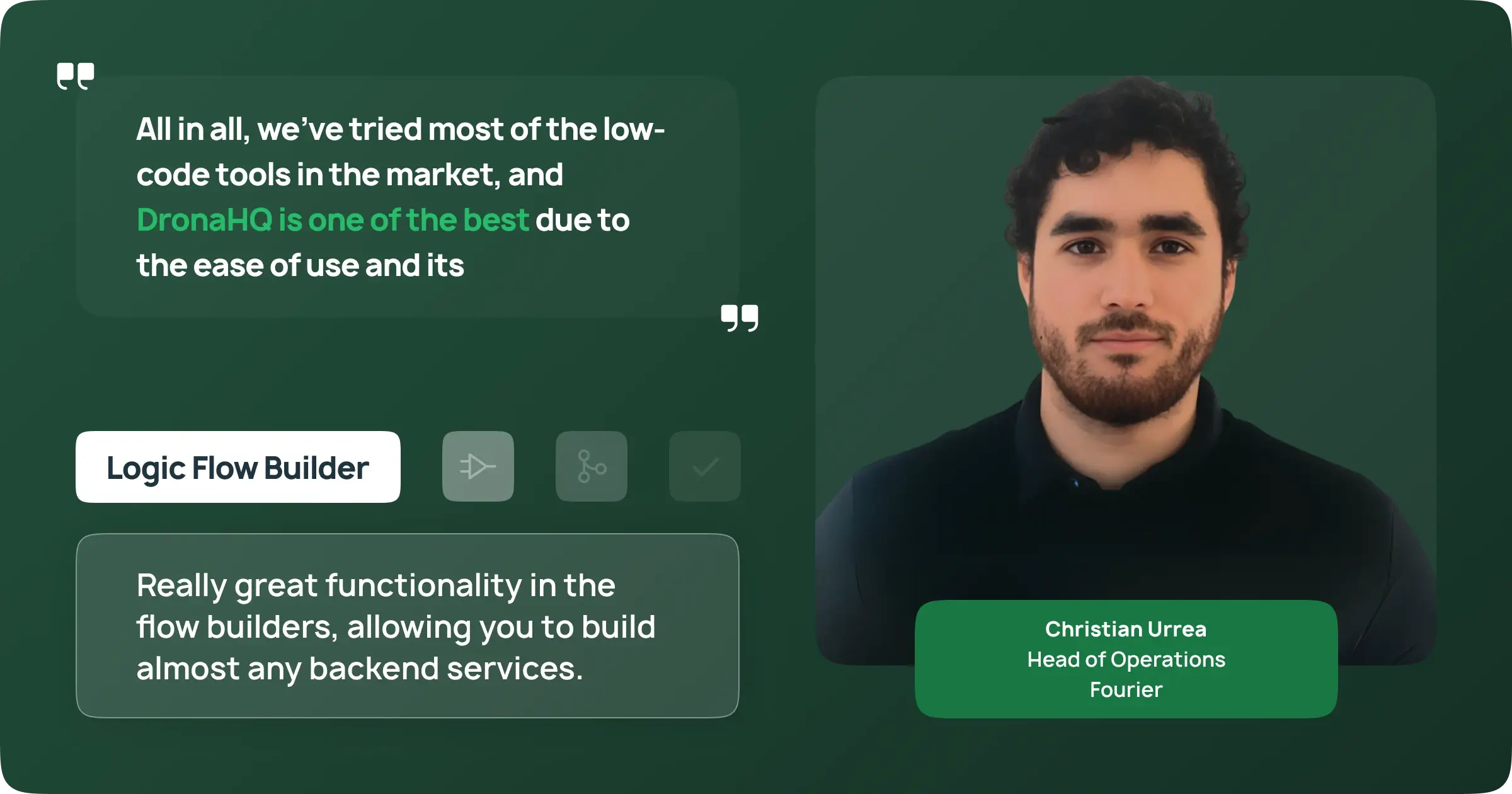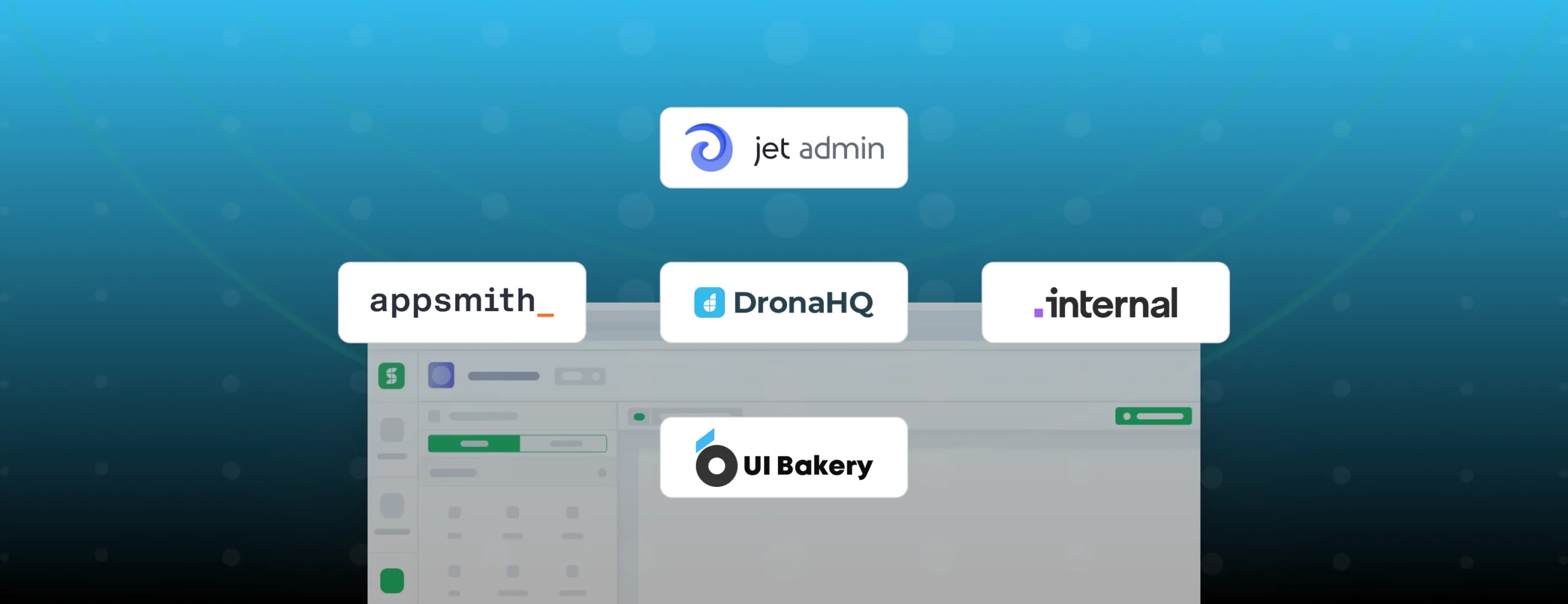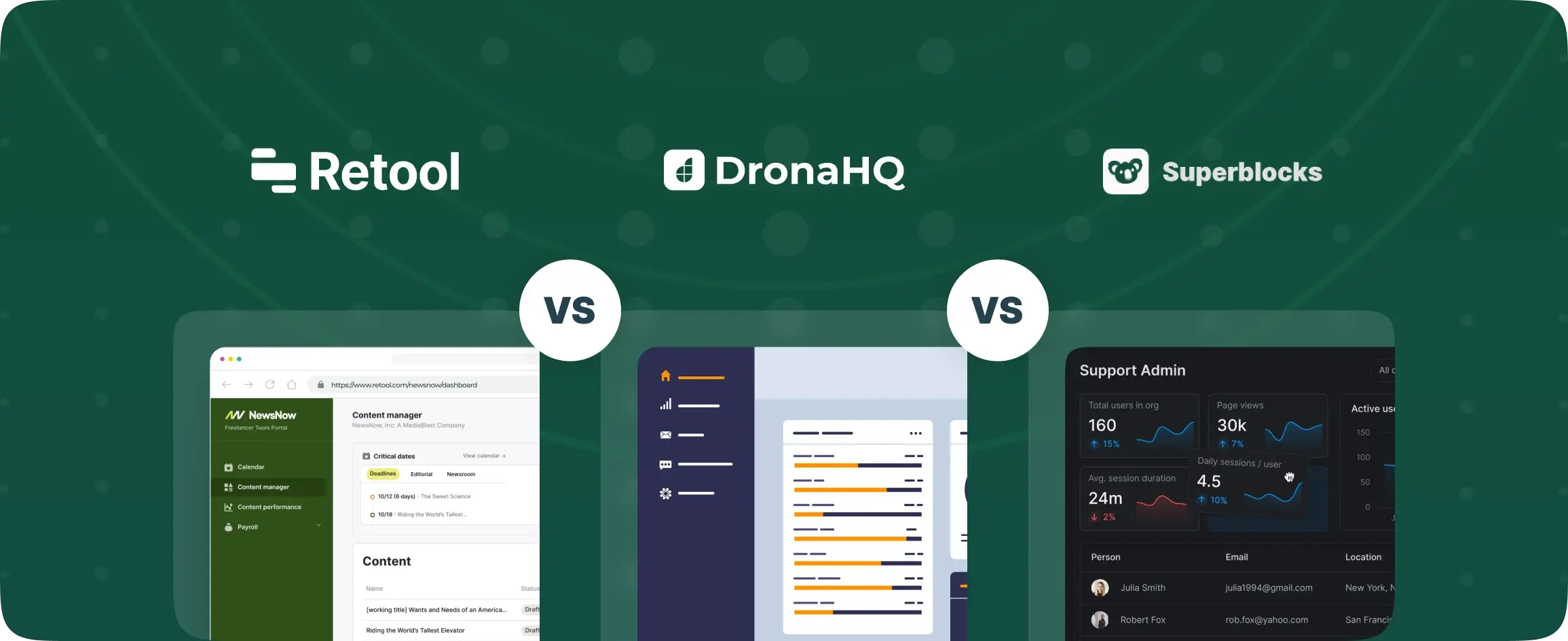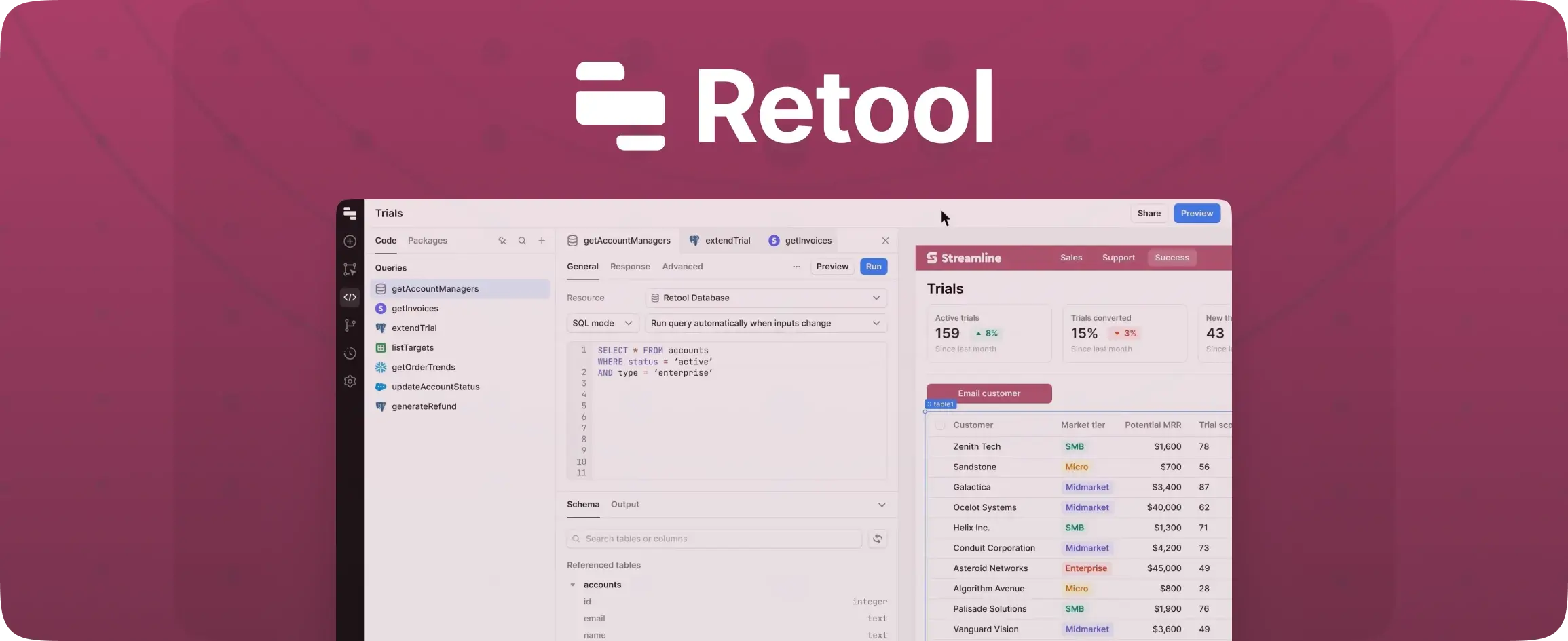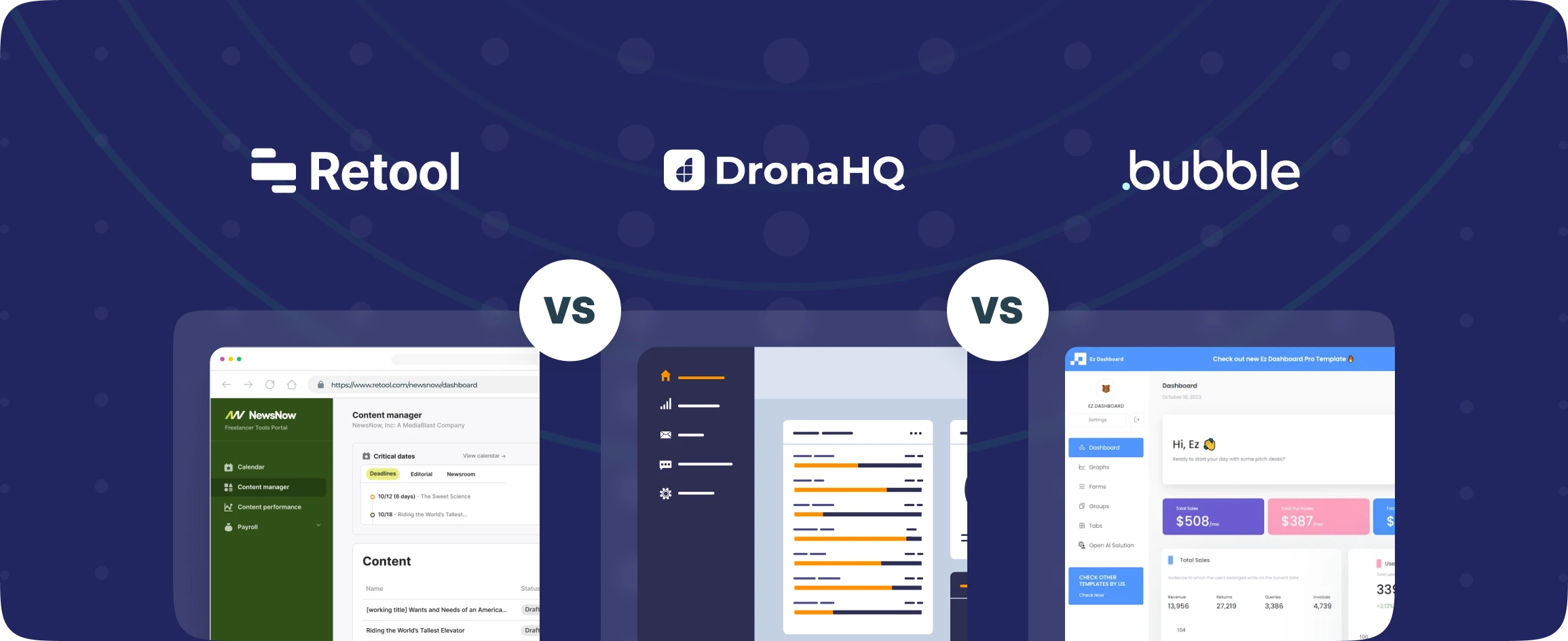

Retool vs Bubble vs DronaHQ – Battle for the best developer toolkit
Businesses and developers are constantly seeking tools that can streamline application development, optimize workflows, and automate processes. Low-code platforms have emerged as game-changers, providing the means to achieve these goals efficiently.
Retool and Bubble.io have carved out significant niches in the low-code and no-code development landscape. Retool is renowned for its developer-centric approach, making it an ideal choice for building data-driven internal tools quickly. Bubble, on the other hand, caters to non-technical users, enabling them to create web applications through a no-code interface. DronaHQ bridges the gap between these two, offering a versatile low-code platform trusted by engineering teams.
In this comprehensive comparison, we’ll delve into the distinctive features, strengths, and limitations of Retool, Bubble, and DronaHQ, addressing some of the most pressing questions developers and businesses face:
- What are the key differences between Retool and Bubble?
- What factors creep up post-platform adoption?
- Why are developers and enterprises choosing DronaHQ over Retool and Bubble?
Quick glance:
| Feature | Retool | Bubble | DronaHQ |
|---|---|---|---|
| Ease of Use | Moderate (developer-focused) | High (non-technical friendly) | High (flexible for all users) |
| Mobile App Support | Different apps need to be built for mobile & web | Responsive web apps | One app for web as well as mobile (native) |
| Public and Private App Capabilities | Limited (enterprise only) | Yes | Yes |
| Component Library | Extensive | Extensive | Extensive |
| Customizable UI | High (requires coding) | Moderate | High (drag-and-drop + coding) |
| Integration with External Data Sources | Extensive | Moderate | Extensive |
| Pricing | Higher (user-based) | Moderate (app-based) | Flexible (user-based and usage-based) |
| Customer Support and Engineering Services | Enterprise plan only | Limited | Yes (business plan onwards) |
| Performance and Scalability | Moderate | Moderate | High |
What is Retool?
Retool is a low-code platform designed for developers to quickly build internal tools. Founded in 2017, Retool provides a rich set of pre-built UI components and extensive integrations, making it ideal for creating data-driven applications.
Retool supports use cases in operations, enabling the creation of tools for managing workflows, automating tasks, and optimizing processes.
Key Features of Retool:
- Developer-Centric: Best for those with a background in JavaScript and SQL.
- Extensive Integrations: Connects with various databases, APIs, and third-party services.
- Custom Code: Supports JavaScript for advanced functionalities.
- Pre-Built Components: Includes tables, charts, forms, and more.
- User Permissions: Granular control over user roles and access
What is Bubble?
Bubble is a no-code platform that allows non-developers to create fully functional web applications without writing code. Founded in 2012, Bubble empowers entrepreneurs and small businesses to quickly bring their ideas to life.
Key Features of Bubble:
- Visual Design Interface: Drag-and-drop editor for building user interfaces.
- Extensive Plugin Marketplace: Access to various plugins for added functionality.
- Responsive Design: Tools for building responsive web applications.
- Data Management: Built-in database for storing and managing application data.
What is DronaHQ?
DronaHQ is a versatile low-code platform that serves both technical and non-technical users. It allows the creation of internal tools, dashboards, and customer-facing applications with ease, offering extensive integrations, visual workflow builders, and robust deployment options.
Key Features of DronaHQ:
- Comprehensive UI Controls: Over 150 pre-built UI components.
- Visual Workflow Builder: Easily define and automate workflows.
- Flexible Integrations: Supports various databases, APIs, and third-party applications.
- Custom Code Support: Allows integration of JavaScript for advanced customizations.
- Deployment Options: Supports both cloud and on-premises deployment.
Retool vs Bubble vs DronaHQ – Frontend capabilities
| Feature | Bubble | Retool | DronaHQ |
|---|---|---|---|
| Drag-and-Drop Interface | Yes | Yes | Yes |
| Built-in Components | Extensive but limited in some areas (e.g., tables) | Extensive | Extensive and customizable |
| Customization | Limited by UI design, requires workarounds | High with JavaScript, but steep learning curve | High with WYSIWYG and advanced editor, supports HTML/CSS |
| Responsive Design | Challenging to implement | Effective but developer-centric | Highly effective and easy to implement |
| Mobile App Support | No native support | Primarily for web and internal tools | Unified development for web and mobile |
| Ease of Use | Steep learning curve for complex logic | Developer-centric, not beginner-friendly | Easy to use with extensive support |
| Pre-built Templates | Available but limited | Extensive | Extensive with themes for hyper-personalization |
| Plugin Library | Extensive but can complicate usage | Limited but effective | Extensive and easy to integrate |
| Custom UI Control Designer | Limited customization | High with JavaScript | Advanced, supports HTML/CSS + custom drag-drop designer |
| Dynamic Themes | Limited theme customization | Limited theme customization | Highly customizable, user-friendly |
Bubble focuses on a visual drag-and-drop interface. Bubble’s built-in components and extensive plugin library offer a broad range of functionalities, although the flexibility in customization can sometimes lead to a steeper learning curve for more complex applications. The absence of native mobile app support can be a limitation for some users.
According to G2 reviews, Bubble’s interface can be cumbersome, with users spending a lot of time locating common elements due to the lack of visual prompts and outdated UI design. While it allows for detailed customization of the front-end, the absence of CSS classes and a weak native ‘table’ component can limit flexibility. Additionally, Bubble struggles with responsive design, making it challenging to ensure applications look good across different devices. The learning curve for complex logic and workflows further adds to the difficulty for users.
Retool employs a structured drag-and-drop interface, facilitating the creation of professional-looking layouts with a wide array of native components. Retool also provides extensive visual reconfigurability options and allows for grouping components into reusable modules, improving efficiency in building similar screens. However, its developer-centric design and the absence of in-app navigation menus can be challenging for less technical users, potentially resulting in a steep learning curve. Retool is designed primarily for creating internal tools, which limits its flexibility for developing customer-facing applications. G2 reviews also suggest that users struggle with personalizing their apps’ UI, making them look alike. Retool has fewer native UI components compared to DronaHQ.

DronaHQ provides a robust drag-and-drop UI builder with a vast library of pre-built components, similar to Retool. However, DronaHQ stands out with its application builder as it provides 2 formats of editors. A WYSIWYG kind and an advanced editor with control over granular elements and CSS properties. Additionally, DronaHQ Themes ensure that apps built can be hyper-personalized to match the user’s requirements. Any app built once can be accessed across a web, Android, or iOS device, allowing developers to build once and deploy across multiple platforms seamlessly. Its control designer feature further enhances flexibility, letting users create and style their UI components using HTML and CSS. Unlike Bubble, DronaHQ excels in responsive design, ensuring applications look good across different devices. The combination of ease of use, extensive customization options, and mobile support makes DronaHQ a superior choice for front-end development.
Retool vs Bubble vs DronaHQ – Backend capabilities
| Feature | Bubble | Retool | DronaHQ |
|---|---|---|---|
| Built-in Database | Yes | Yes | Yes |
| External Database Integration | Yes, but performance issues | Yes, robust | Yes, extensive |
| API Integration | Yes, but can be complex | Yes, robust | Yes, extensive |
| Backend Workflow Configuration | Visual, but limited | Visual and JavaScript | Visual and JavaScript |
| Custom Logic | Limited, requires plugins | Extensive, requires coding | Extensive, supports visual and code |
| Performance | Issues with data-heavy apps | Generally good, can lag with complexity | Generally good, greater control over API/DB calls |
Bubble provides a built-in database and supports integrations with external databases and APIs. However, users have reported limitations in handling complex backend operations and performance issues with data-heavy applications. Bubble’s backend workflows are designed to be configured visually, which can be both a strength and a limitation, as more advanced logic requires complex workarounds or additional plugins.
Retool offers powerful backend integration capabilities, allowing connections to a wide range of databases and APIs. It supports advanced data operations and custom scripts in JavaScript, providing flexibility for developers. Retool’s focus on internal tools makes it highly effective for managing complex backend workflows and data visualizations. However, it requires a certain level of technical expertise, which can be a barrier for non-developers.
DronaHQ excels in backend capabilities by offering extensive data source integration. It supports connections to various databases, APIs, and third-party services, providing robust data handling capabilities. DronaHQ’s backend logic can be configured visually through action flows, simplifying complex data operations. Additionally, it supports server-side scripting with JavaScript, enhancing flexibility for developers who need custom backend logic. DronaHQ’s combination of visual and script-based backend configuration provides a balanced approach. DronaHQ goes the extra mile by offering Multistep Authentication—a nested or custom authentication method enabling users to provide multiple forms of authentication for enhanced security.
All three platforms boast a vast library of database and third-party integrations, with DronaHQ coming on top by providing SFTP and FTP connectors as well, allowing developers to seamlessly connect to a variety of data sources and services.
Retool vs Bubble vs DronaHQ – Logic building capabilities
| Feature | Bubble | Retool | DronaHQ |
|---|---|---|---|
| Visual Workflow Editor | Yes, limited flexibility | No | Yes, highly flexible |
| Custom Logic Support | Limited, requires workarounds | Extensive, JavaScript | Extensive, visual and code |
| Ease of Use | Steep learning curve for complex logic | Requires coding knowledge | Easy with visual and code options |
Bubble offers a visual workflow editor for logic building, but users have reported difficulties with complex logic and arbitrary bugs that require convoluted workarounds. While it excels in creating simple to moderately complex workflows, advanced logic and customizations can be challenging and might require extensive troubleshooting.
Retool excels in logic building with its ability to incorporate custom JavaScript code. It allows for detailed and complex logic flows, making it ideal for developers familiar with coding. However, this can also make it less accessible for non-technical users. The reliance on JavaScript for advanced functionalities might be a hindrance for those without coding experience.
DronaHQ simplifies logic building with its visual action flow builder, allowing users to create complex workflows without writing code. This feature is particularly useful for automating business processes and integrating various data sources. Additionally, DronaHQ supports custom scripting for more advanced logic, providing a balance between ease of use and flexibility. The ability to visually define logic flows and add custom scripts as needed makes DronaHQ a versatile platform for logic building. DronaHQ’s logic builder stands out to customers for the number of pre-built action blocks supported.

Retool vs Bubble vs DronaHQ – Deployment & Sharing
| Feature | Bubble | Retool | DronaHQ |
|---|---|---|---|
| Hosting | Integrated, no self-hosting | Self-hosting and cloud | Self-hosting and cloud |
| Sharing Options | Limited | Robust for internal use | Extensive, public links, embeds |
| Version Control | Basic | Comprehensive | Comprehensive |
| Multiple SSO | No | No | Yes |
| Custom SSO | Yes (Limited) | Yes | Yes, Business Plan onwards |
| Granular Permissions | Limited | Yes | Yes |
| App and User Analytics | Limited | Available (Business Plan) | Available (Business Plan) |
All three platforms provide the flexibility of cloud-based or self-hosted solutions, but DronaHQ shines with its inclusive approach to user management, offering unlimited users across self-hosted plans.
Retool imposes a limit of up to 25 users in its business plan, potentially making it a costlier option for larger teams.
Additionally, DronaHQ simplifies version control with its global Git Sync feature, enabling seamless integration with Git hosting providers like GitHub, GitLab, and Bitbucket, while source control management is typically considered an enterprise feature that Retool offers. DronaHQ breaks the norm by offering Git-based source control in all plans, empowering organizations of all sizes to leverage industry-standard version control tools for managing changes to their applications.
One standout feature exclusive to DronaHQ is Multiple Single Sign-On (SSO), enabling organizations to utilize several SSO identity providers for authentication management—an invaluable asset for enhancing security and user access control. This feature sets DronaHQ apart from its counterparts, as Retool and Bubble do not offer similar functionality.
While version control and audit logs are available across all platforms, Bubble’s limitations are apparent with its outdated UI and lack of real-time collaboration features. In contrast, DronaHQ provides robust audit logs, albeit restricted to its enterprise plan.
DronaHQ compensates with comprehensive app analytics, including app, user, and portal insights, available across all plans. Retool, on the other hand, restricts app analytics to its enterprise plan, limiting accessibility to critical performance insights for users on lower-tier plans.
Retool vs Bubble vs DronaHQ – Pricing table
Bubble has a straightforward pricing model based on the number of applications and features used. While it offers a free plan, advanced features and higher usage limits come at a cost, which can add up for larger projects. The pricing can become expensive for complex applications with high data usage.
Retool follows a user-based pricing model, which can become expensive as the number of users increases. Its pricing structure is more suited for larger organizations with specific internal tool needs. The cost can be a barrier for small to medium-sized businesses with limited budgets.
DronaHQ offers flexible pricing plans, including user-based and usage-based options, making it accessible for businesses of all sizes. It’s competitive pricing and extensive feature set
Retool vs Bubble vs DronaHQ – Which one to choose?
Choosing the right low-code platform depends on the specific needs and requirements of your project. Bubble offers a user-friendly drag-and-drop interface, making it accessible for non-technical users, but it has limitations in customization, performance, and mobile app support. Retool is a powerful tool for developing internal applications with extensive backend capabilities and customization options, although it requires technical expertise and can be expensive for larger teams. DronaHQ stands out with its comprehensive feature set, supporting both web and mobile platforms, extensive customization, robust deployment options, and competitive pricing, making it the superior choice for a wide range of application development needs.
Got more questions about DronaHQ? Book a free call with us!
